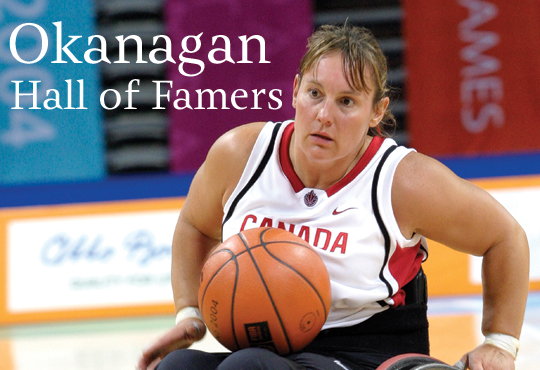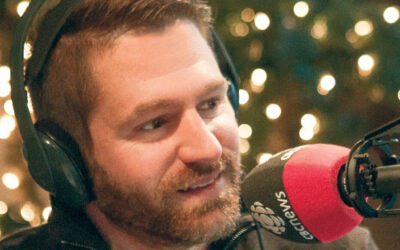
Their athletic exploits brought us to our feet, swelled our hearts with pride, took our breath away. Their stories have slipped from the spotlight, but the accomplishments of these extraordinary Okanagan sports heroes stand the test of time. ~
Marni Abbott-Peter: Athlete of the Century
Enderby’s Marni Abbott was on her way to becoming the next Nancy Greene. Until age nine, she lived next door to the woman who would become Canada’s Female Athlete of the Century. Naturally, Marni’s first sports love was skiing, introduced to the rush of flying down a mountain slope by her older brother.
“He enrolled in the ski team and I wanted to be just like him,” says Marni. “I wasn’t going to be the girl who was left at home on the couch on Sunday morning watching Bugs Bunny.”
An excellent athlete, Marni progressed rapidly and was soon racing. But one day while doing about 75 kilometres per hour speeding down a run at Silver Star, the 18-year-old crashed. When she came to a stop, Marni realized her legs wouldn’t move. Not only had she fractured her skull, cheekbone and three ribs, but her back was broken at the fourth thoracic vertebra.
“I had this understanding within me, even though I was laying on the mountain within seconds of breaking my back, that my life was going to be different from there on. It was a spiritual sort of experience in a way.” Some would have abandoned their sports ambitions right there.
Marni was flown to the GF Strong Rehabilitation Centre in Vancouver to begin the long road of recovery. After meeting a young Rick Hansen about to embark on his historic Man in Motion World Tour, Marni emerged inspired and with a whole new outlook.
“He’s telling me about how he’s going to wheel around the world and I’m thinking to myself, ‘I can’t even make it to the cafeteria at the end of the hallway,’” she recalls. “If he could do that, then I knew I could do whatever I decided to do, too.”
Rather than dwelling on the overwhelming obstacle placed abruptly before her, she chose to overcome it. “I believe things happen for a reason, that there are no accidents in life,” she says.
Besides Rick Hansen and Terry Fox, few BC athletes have overcome more to achieve so much. Within three years of the accident, Marni was swimming for Canada at the Pan American Games in Puerto Rico, where she won five medals.
Yet wheelchair basketball is where Marni truly made her mark. She discovered the game in 1988 after meeting coach Tim Frick and within four years had won a place on the national team. For a dozen years she remained a pillar of an international dynasty the likes of which the sport had never seen. In that time Marni and the Canadian women won three Paralympic gold medals and one bronze, three straight world championship titles, and embarked on an incredible 43-game undefeated streak in Paralympic and world championship play.
Marni cites being chosen as Canada’s flag bearer during the Opening Ceremonies of the 1996 Paralympics as her career highlight. She says it was a surreal experience wheeling the maple leaf around the track in front of 80,000 people made even more special by the fact her parents were in the crowd.
“I noticed at the far end there were these two people that had everything—balloons, mascots, and all red and white and faces painted,” Marni laughs. “Everyone kept pointing at these two crazy people and so I get closer and I realize it’s my parents!”
In 2005, she married fellow national team veteran Richard Peter. Both have since been inducted into the BC Sports Hall of Fame, served as co-mayors of the Athlete’s Village at the 2010 Paralympic Games in Vancouver, and stand as two of the most decorated Paralympic athletes in Canadian history.
She currently works for the BC Wheelchair Basketball Society, coaches the BC provincial women’s team, and coordinates the Let’s Play program in BC, which delivers physical activity programs to children with and without disabilities.
Like her early role model Nancy Greene, Marni has also been named an Athlete of the Century, earning the honour from the BC Wheelchair Sports Association in 1999. Nothing better illustrates what she gave to her sport and the high esteem in which she is held.
Ivan McLelland: The Golden Goaltender
Meeting Ivan McLelland today, a quiet, humble man of 82, you’re struck by a sense of calm that seems to surround him. He might be the most “normal” hockey goaltender you’ll ever meet. In Penticton, he’s a living legend. People he’s never met say hello to him by name on the street. Minor hockey coaches seek him out to speak to their teams and the youngsters hang on his every word. Ivan is friendly, approachable, level-headed—nothing like so many of the clichéd, quirky neurotics who put their bodies in front of 100-mph flying discs of frozen rubber for a living.
On a dysfunctional Penticton Vees juggernaut, he was the rock that wouldn’t flinch when the chips were down. Without knowing his backstory, few would pick him out of a line-up as the man who held the fort during the opening salvos of the greatest rivalry in hockey: Canada versus Russia.
The Vees represented Canada at the 1955 World Ice Hockey Championships in Germany. Ivan played every minute of an incredible 102 exhibition, league, and playoff games for the Vees on their Cup run.
Canadian pride had been bruised the previous year when the Soviet Union embarrassed our team 7–2; the first time the emerging quasi-professional powerhouse knocked Canada off for the world title. Critics said sending the country’s best amateur team was no longer good enough to compete against the best of Soviet Russia—especially a team from tiny Penticton, population approximately 9,000. Apparently the Vees didn’t get the memo.
On March 6, 1955, Ivan and the plucky Penticton boys restored a good deal of Canadian pride in the tournament’s climactic game with a 5–0 shutout over the Soviets to capture the world championship. Canadians listening at home to Foster Hewitt’s radio play-by-play went berserk. Key to the Vees’ victory was their unflappable puckstopper, Ivan, who won all eight games for Canada in the nine-day tournament, posting a sparkling 0.75 goals against average.
Ivan’s rise to the pinnacle of world hockey was just as unlikely. He was raised in the heart of the Depression in the northern Ontario mining town of South Porcupine. If you didn’t want to end up toiling in a mine your entire life, hockey was one of the few ways out. A New York Rangers scout spotted him playing Senior A hockey and he was signed to the Rangers’ minor league team in Vancouver.
The Pacific Coast Hockey League Canucks only carried one goaltender, so owner Coley Hall dispatched Ivan to the expansion Penticton Vees in 1951, a town the young goaltender had never heard of. No matter, it was just going to be a brief stopover—or so he thought.
Ivan fell in love with Penticton almost immediately and, except for a short spell in Vancouver, he never left. “Coming from a small mining community to this beautiful setting was the initial attraction,” says Ivan. “And then the enthusiasm of the people in Penticton to hockey. It was like a fairytale.”
Penticton also offered more than picturesque lakes and fervent fans. Ivan fell in love with Faye, a beautiful girl he met his first week in town ice skating at the local pond. They were married for 57 years and raised three children.
After getting a serious look from the Montreal Canadiens, Ivan retired after 396 games in a Vees’ jersey. He turned to coaching minor hockey and was successful there too, guiding Penticton’s first-ever midget AAA BC championship team. A young Bob Nicholson, future president and CEO of Hockey Canada, was captain of that team.
Ivan later worked as a regional manager for Nielson’s Chocolates and in RV manufacturing. In 2005, he was inducted into the BC Sports Hall of Fame.
Last year, he self-published a great biography of his life entitled Gold Mine to Gold Medal, selling nearly a thousand copies with no promotion. He donated all proceeds to Penticton’s Good Samaritan Society for dementia care. Currently, he is pursuing a publisher to distribute his story nationwide.
Ted Bowsfield: The Penticton Peach
Boston sports writers dubbed him the Penticton Peach, but it’s safe to say that batters facing Ted Bowsfield’s 105-mph fastball thought he was anything but sweet.
Born in Vernon and raised in Penticton, Ted was the first BC ballplayer to stick in the major leagues for an extended period, playing seven seasons with the Boston Red Sox, Cleveland Indians, Los Angeles Angels and Kansas City Athletics. He compiled a career win-loss record of 37-39 in 215 appearances with 326 strikeouts.
Ted first started to play catch on visits to his grandparents in Vernon. His mother and her two sisters all played on a girls’ baseball team during the war years. “I think my athleticism comes from that side of the family,” he says.
Yet it’s a miracle he made it to the big leagues. There was no Little League in Penticton then, but Ted’s father worked tirelessly setting up games with teams in surrounding towns like Hedley, Oliver, even Peachland. Ted and his teammates all piled into his father’s old Hudson and off they’d go. The lefthander was lucky to play eight games a year for much of his youth, hardly enough for a pitcher to develop. “I was very fortunate I made it as far as I did. The odds of it happening were not too great.”
Ted had a number of things in his favour. He was a fantastic all-round athlete who excelled in basketball, hockey, and track and field. He later turned down basketball scholarships to Gonzaga and Seattle University. Penticton was also blessed with very good semi-pro baseball. By age 15, Ted was playing against men, a tough training ground for a young pitcher learning his craft.
“I could throw hard and I was pretty wild, but my catcher Sam Drossos was just a wonderful athlete and a great person who could settle me down,” says Ted. “To this day we’re still friends.”
By his last two years of high school in 1953-54, scouts were circling. His pitches left clouds of smoke and confounded hitters. Boston’s northwest scout Earl Johnson, who had earlier spotted fellow BC Sports Hall of Famers Sandy Robertson and Arnie Hallgren, signed Ted for $4,000. When he made his Red Sox debut in 1958, his first major league contract was for $8,000. The most he ever received was $16,000, light years from the tens of millions thrown around today.
As the talented rookie found his feet on a roster that boasted the legendary Ted Williams, it became clear Ted had an uncanny skill that would keep any pitcher in the majors.
He was a Yankee killer.
Among his career highlights, Ted underlines one item with relish: “Beating the Yankees!” Three times that first season he defeated a strong Bronx Bombers team featuring the likes of Mickey Mantle and Yogi Berra. “This youth is slick,” said venerable Yankee manager Casey Stengel.
As persistent arm and shoulder problems gradually ate away at his shotgun arm over the next six years, the smoking heater faded and Ted learned to rely on a curve and screwball to get by. His best overall season came in 1961 going 11-8 with the expansion Angels, the only LA starter to post a winning record that year. By age 29, the arm pain was so bad he hung up his glove for good. He has no regrets. “I always felt fortunate that every day in the major leagues was a dream come true. Every day was a blessing.”
After retiring, Ted managed Anaheim Stadium, Seattle’s Kingdome and the Tacoma Dome. While running a consulting business he worked on BC Place Stadium and Toronto’s SkyDome. Today Ted works part-time as a marshal and junior coordinator at Cypress Ridge Golf Course near his home in Nipomo, California.
Recently, a steady stream of BC ball players has flowed to the majors. When asked how it feels to have played some small role in blazing the trail, Ted remains humble. “They’re good ballplayers and they’ve earned their stripes. I give them a lot of credit for making it there.”
No one knows better than the Penticton Peach how tough that road can be.
The Amazing Family Athans: BC’s Greatest Sports Clan
Dr. George Athans’ buddies teased him about the rural cottage he bought “out in the boonies” overlooking Okanagan Lake. But they weren’t teasing for long. Besides beautiful surroundings and a wise move financially, Dr. Athans suddenly owned an unmatched natural playground perfect for raising a young, sports-minded family—the greatest our province and arguably our country have known.
“We were living the Okanagan version of the Beach Boys,” says eldest son George Jr. “A constant stream of 60s rock music, hangin’ out on the beach, water skiing, swimming and diving. We thought everyone lived like that.”
Son of pioneering Greek-Canadian parents, George grew up near Vancouver’s Jericho Beach. He became one of Canada’s best divers, earning renown far beyond Vancouver. Legendary tales are still spun of his diving off the Burrard Street Bridge. He represented Canada at two Olympic Games in tower and springboard—the first in Berlin in 1936 at age 15. At the 1948 London Olympics, he saved the Canadian Olympic Association thousands by pulling double duty as both competing athlete and team doctor. At the 1938 British Empire Games, he won two bronze medals and added a gold and silver in 1950. He then retired to focus on his medical practice and served as Canadian diving coach at the 1960 Olympics in Rome.
George first met Irene Hartzell at aquatic competitions in the late 1930s. Irene, who was Manitoba diving champion and self-taught five-time Canadian synchronized swimming title-holder, also swam nationally. The couple married in 1950 and moved to Kelowna, familiar to both because of its world-famous Regatta. After taking a break to raise three boys, Irene returned to competitive masters swimming in her late 50s and won piles of Canadian titles plus a few age group world records.
“I like to say that Nike stole my mom’s slogan: ‘Just do it,’” jokes youngest son Gary. “She just went out and did it without thinking too much about it. She probably has more titles than all of us.”
George and Irene encouraged the boys, but let them choose their own paths. George Jr. won the world water skiing championship twice (1971, 1973), held the Canadian title for 10 years and was one of the youngest Order of Canada recipients ever at age 21. Forced into early retirement by a knee injury, he was a CBC sports commentator for 16 years.
Greg became a freestyle skiing pioneer before the discipline was added to the Winter Olympics. The undisputed best of his era, he won four world overall titles, two world mogul championships and one world ballet crown. He was also an accomplished water skier, winning eight national titles. Following retirement, he became one of Canada’s leading professional photographers.
After diving and water skiing very successfully in his teens, youngest son Gary chose the thrill of downhill ski racing. He spent eight years on the Canadian alpine ski team highlighted by representing Canada at the 1984 Winter Olympics where he finished 20th in the downhill. That season he was ranked 17th in the world. After retiring he worked at Big White and Whistler and ran a water skiing school.
“We grew up in the right environment at the right place at the right time,” says George Jr. “If you wanted to be involved in sports, what better place than a lake in front of you, five ski hills within forty minutes’ drive, and other athletic facilities. All you had to do was apply yourself.”
Today, downtown Kelowna has crowded in around the Athans family home, once considered “out in the boonies.” Dr. Athans passed away in 2007 at the age of 86, a year after his middle son Greg succumbed to diabetes complications at age 51. Irene continued to set masters swimming records into her 80s and still lives in Kelowna at age 90. George Jr. runs his own Montreal-based TV and film production and communications company. Gary is one of the Okanagan’s most successful residential realtors.
If there were a Canadian hall of fame for entire families, the Athans clan would certainly be included—by unanimous first-ballot vote. On quantity, quality and diversity, even other great athletic family acts like the Hulls, Patricks, Howes, Sutters or Staals don’t stack up.
Spring 2013 | Digital EditionSo what does it feel like to be considered BC’s and arguably Canada’s first family of sport?
“It gives me a tingle up my spine,” says Gary.
“It’s quite the tribute,” agrees George Jr.
And the family history doesn’t appear to be complete. Gary’s son Isaac has won Okanagan skiing events, while 12-year-old Marcus won the Canadian junior waterskiing championship last summer.
Look out, the next generation has taken up the Athans family torch.
New Hall of Famers
In January, two Okanagan athletes were announced as 2013 inductees into the BC Sports Hall of Fame: Naramata’s Robert “Ro” Hindson and Vernon’s Larry Kwong. Hindson is considered one of Canada’s greatest rugby players, an all-round talent who accumulated a then-record 31 international caps. Kwong was the first Chinese-Canadian to play in the NHL when he suited up for the New York Rangers in 1948. These two individuals will be inducted along with the rest of the 2013 induction class at the BC Sports Hall of Fame’s 45th annual Banquet of Champions on September 19, 2013 at the Vancouver Convention Centre. ~ Story by Jason Beck



0 Comments